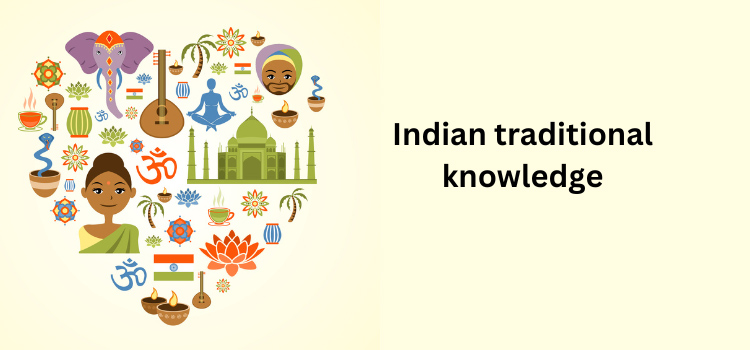Indian Traditional Knowledge
Posted On : September 23, 2023

Table of Contents
Definition of Traditional Knowledge
According to WIPO, “Traditional knowledge (TK) is knowledge, know-how, skills and practices that are developed, sustained and passed on from generation to generation within a community, often forming part of its cultural or spiritual identity”.
The term "traditional knowledge" is currently used by WIPO to describe works of literature, art, and science that are based on tradition, as well as performances, inventions, scientific discoveries, designs, marks, names, and symbols, undisclosed information, and all other tradition-based innovations and creations that are the result of intellectual activity in the fields of industry, science, literature, and art.
According to UNESCO, “Traditional Knowledge refers to the knowledge, innovations and practices of indigenous and local communities embodying traditional lifestyles relevant for the conservation and sustainable use of biodiversity.”
Importance of Traditional Knowledge
Most local communities' identities are rooted in their traditional knowledge (TK). It has a significant role in the social and physical environment of a community, so preserving it is crucial. The interests of its lawful custodians may be harmed by attempts to misappropriate TK or to use it for industrial or commercial purposes. TK must be protected and nurtured for sustainable development in accordance with the interests of TK holders in the face of such hazards.
For developing nations in particular, it is crucial to preserve, defend, and promote local communities' inventions and practices that are founded on traditional knowledge. Their TK and biodiversity endowment, which is rich, is essential to their development, trade, environment, culture, religion, identity, and health care systems. However, this priceless resource is in danger in many regions of the world.
Why does traditional knowledge need to be safeguarded?
Traditional knowledge is crucial to a community's moral character. These knowledge systems are necessary for livelihoods. In addition to preventing exploitation of traditional knowledge, Indian patent protection for it will also aid in the documentation of these knowledge repositories.
Since so many of these ancient knowledge systems are passed down orally, it can be challenging to determine their exact origins. This then makes it possible to profit from traditional knowledge systems.
Preventing the commercial exploitation of this knowledge system is one of the main reasons for protecting traditional knowledge.
In actuality, natives and indigenous people are quite concerned about biopiracy. Natural materials with medicinal characteristics, such spices and herbs, have been employed by many indigenous communities. Large corporations are now utilising these techniques without giving the creators of them the proper credit. The term for this is bio-piracy. Communities that practise unani or ayurveda, for instance, worry that the pharmaceutical and cosmetics businesses are profiting greatly from their knowledge (which has been amassed over generations).
Challenges in protecting traditional knowledge
In terms of safeguarding traditional knowledge, inadequacy of laws is merely one aspect of the issue. In the effort to preserve traditional knowledge, additional difficulties arise:
- The majority of the time, traditional knowledge is passed down verbally from one generation to the next. It becomes challenging to trace the history of the knowledge system without written records. The issue is even more difficult in India because traditional knowledge is spoken in a wide variety of languages and dialects. For instance, it is unknown where yoga first originated because there is no written documentation. Many have maintained that yoga was first referenced in the Vedas, despite several sources suggesting that the practice existed throughout the pre-Vedic era. Without a reliable source, it is challenging to defend a community's traditional knowledge against claims of ownership from other groups.
- Most intellectual property rights, such as patents and copyrights, are given for a set amount of time, such as 10 or 20 years. The duration of protection in the case of traditional knowledge is contentious. It's unclear how long conventional knowledge systems can be preserved, especially because those knowledge systems are always changing.
- Traditional knowledge systems are not specifically protected by any legislation. Existing laws can be utilised to defend the rights of communities in some instances and under certain circumstances.
India’s Perspective
Millions of traditional and Indigenous people around the world express their cultural identities through their traditional knowledge (TK) and traditional cultural expressions (TCEs). India has a rich, distinctive culture that has changed through thousands of years and is specific to each region. The first word that comes to mind when we think of a knowledge tradition is "Vedas." India has always been renowned for its culture and heritage of learning.
The contribution of India to knowledge has been acknowledged by ancient civilizations. Indian traditional knowledge has been accessible for tens of thousands of years in a variety of formats, including oral transmission, manuscripts, and classical texts. When we speak of knowledge, we are referring to language, philosophy, the inevitability of knowing, folklore, and sculptures.
The Indian Constitution guarantees its citizens the Fundamental Rights to equality, equal opportunity, life, and personal liberty, as well as the freedom to maintain a distinct language, script, or culture. Article 29(1) states that any group of individuals living in any area of India who speak a unique language, use a unique script, or have a unique culture have the right "to conserve the same."
What actions has the Indian government taken to document TK?
However, India does not have any explicit regulation protecting traditional cultural expressions and knowledge. Still, there are some provisions in various laws that can be used to protect traditional knowledge, including the Patent Act of 1970, the Plant Variety Protection and Farmers Rights Act of 2001, the Biological Diversity Act of 2002, the Geographical Indications of Goods (Registration and Protection) Act of 1999, the CopyRight Act of 1957, the Trade Marks Act of 1999, the Designs Act of 2000, etc.
Averting its economic exploitation is among the most crucial justifications for protecting traditional knowledge. India is the main supplier of such traditional medicinal systems as well as medicinal plants since between 2500 and 500 BC, India produced several concepts such as Ayurveda, Siddha, and Unani. Because of this, India has a vast traditional knowledge of many different resources, including the pharmaceutical system. The issue of biopiracy is one that natives and indigenous groups take very seriously. Numerous indigenous societies have used natural ingredients for therapeutic purposes, such as spices and plants. Without giving credit to the individuals who devised them, large organisations use these techniques.
Traditional Knowledge Digital Library
The Traditional Knowledge Digital Library (TKDL) is a ground-breaking project of India, under the joint collaboration of the Council of Scientific and Industrial Research (CSIR) and Ministry of Ayurveda, Yoga & Naturopathy, Unani, Siddha, Sowa Rigpa and Homoeopathy (AYUSH), to stop exploitation and to protect Indian traditional knowledge at Patent Offices around the world.
Ayurveda, Siddha, Unani, and Sowa Rigpa, as well as yoga practices, are the current focus of the Traditional Knowledge Digital Library, which was designed to break down language and format barriers by methodically and scientifically structuring the available contents of the ancient texts into five different international languages: English, Japanese, French, German, and Spanish.
For the creation of TK databases based on TKDL specifications, TKDL has also established worldwide specifications and standards. The Intergovernmental Committee on Intellectual Property and Genetic Resources, Traditional Knowledge, and Folklore Expression of the World Intellectual Property Organization (WIPO) accepted this at its fifth session in 2003.
The Neem Case
W.R. Grace and the United States Department of Agriculture first submitted the patent for neem to the European Patent Office. According to the aforementioned patent, fungus on plants can be controlled by touching them with a formulation of Neem oil. India has filed a lawsuit to challenge the patent's granting. The Research Foundation for Science, Technology and Ecology (RFSTE), based in New Delhi, filed a lawsuit opposing this patent in collaboration with the International Federation of Organic Agriculture Movements (IFOAM) and Magda Aelvoet, a former green MEP.
The Neem tree, a famous tree in India, is home to a number of powerful substances, most notably the chemical azadirachtin, which is contained in the seeds of the tree. In so many different disciplines, it serves as an astringent. Leprosy, diabetes, skin conditions, and ulcers are just a few of the maladies that can be treated using the bark, leaves, blossoms, and seeds of the neem tree. Since ancient times, neem twigs have been utilised as antibacterial teeth brushes. The opposition's submission of information from ancient Indian ayurvedic literature describing how neem extracts, which are hydrophobic, have been utilised for ages in India to treat both human and animal dermatological disorders, defending cultivated plants from fungus infestations.
The patent was cancelled by the EPO because it lacked novelty, an innovative step, and potentially even relevant previous art. In addition, Neem-based emulsions and solutions recently lost a number of US patents.
The Turmeric Case
East India is the home of the tropical herb turmeric. India uses turmeric powder extensively as a culinary additive, medicinal, and dye, to name a few applications3. For instance, it is used as a blood purifier, to treat the common cold, and as an antiparasitic for many different types of skin infections. A lot of Indian cuisines also require it as a crucial element.
For its ability to heal wounds, turmeric was granted a patent by the United States in 1995 to the University of Mississippi Medical Center. The use of "turmeric powder and its administration", both orally and topically, for wound healing, was the claimed subject matter. It has been given the sole authority to sell and distribute.
The United States Patent and Trademark Office (USPTO) received a written objection from the Indian Council for Scientific and Industrial Research (CSIR) against the patent that was awarded. It was a monumental endeavour to uncover written literature on the use of turmeric powder through oral as well as topical routes for wound healing, even though it was generally known that the usage of turmeric was known in every household in India since centuries. 32 references in Sanskrit, Urdu, and Hindi were found after thorough investigation in these three languages.
Consequently, the patent was cancelled by the USPTO, who agreed that using turmeric to treat wounds was an ancient practice and that the claims stated in the invention were apparent and anticipated. As a result, in the turmeric case, the TK that belonged to India was protected.
The Basmati Case
The US Patent and Trademark Office granted 'RiceTec' a patent for a variety of aromatic basmati rice, which has been farmed for millennia in Pakistan and India. Ricetec also noted in its 1997 patent application that "high quality Basmati rice typically come from northern India and Pakistan. In fact, in some nations, the phrase only refers to basmati rice produced in Pakistan and India. The business continued, nevertheless, by asserting that it had created a few "novel" Basmati lines and grains "which enable the production of high quality, higher yielding Basmati rice throughout the world."
Out of the 20 claims stated in RiceTec Inc.'s first patent application, the Indian Government had only attempted to appeal 3. Only statements about a few aspects of basmati (namely the starch index, aroma, and grain diameters) were being disputed. The WTO Agreement does not mandate that nations grant plant variety patent protection. It just requires nations to enact laws that protect plant types in some capacity (and not always through patents).
The patent application was nonetheless approved by the US since it strongly supports plant variety patent protection. Three strains created by RiceTec are eligible to use the name "Superior Basmati Rice" and are granted patent protection. Therefore, in the Basmati case, RiceTec changed the strain by breeding it with the Western strain of grain and successfully claimed it as their innovation. The case serves as an illustration of the issues with patenting biotechnological procedures that are highlighted in TRIPS.
Conclusion
Traditional knowledge offers enormous promise for resolving man's emerging difficulties. Exploiting this knowledge is critical, but it must be accompanied with safeguards, promotion, and benefit sharing.
India is the only country in the world that has established an institutional framework to safeguard its TK, known as the TKDL. The TKDL allows for the quick and nearly free cancellation or withdrawal of patent applications relating to India's TK.
The TKDL has so far made it possible to cancel or withdraw a significant number of patent applications that sought to assert ownership over the use of various therapeutic plants. The TKDL in India is a special tool that is essential in preserving the nation's traditional knowledge.
























